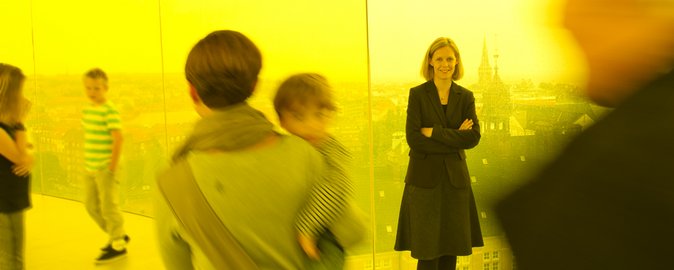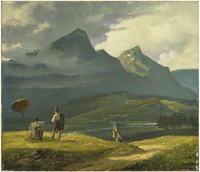- Education
-
Research
Current research
Talent
-
Collaboration
Businesses
Government agencies and institutions
Alumni
-
About AU
Organisation
Job at AU
When the whole concept of tourism arose back in the Golden Age, there was also an anti-tourism movement. Artists rejected the idea of being streamlined tourists in favour of what they regarded as a more authentic form of travel. And the hunt for authenticity is still going on in the modern world.
2013.06.24 |

Karina Lykke Grand is responsible for a major research-based Golden Age exhibition at ARoS entitled GOLD – treasures from the Danish Golden Age. In the exhibition she gives us an entirely new perspective on the Golden Age.

Golden Age artists often used to paint each other at work. These paintings reflect their own self-image as lonely, hard-working individuals. But this was not the whole truth about their lives, explains assistant professor Karina Lykke Grand. The truth is that the artists liked company, and cafés were used to create small tourist enclaves. Wilhelm Bendz, Bjerglandskab, approx. 1831. Oil on canvas, 28.9 x 33.9 cm. Belongs to the Hirschsprung Collection, Copenhagen. Photo: The Hirschsprung Collection.

When the phenomenon of tourism arose in the Golden Age, an anti-tourism movement started as well. The anti-tourists often regarded tourists as lazy English noblemen who only went abroad to enjoy themselves. Wilhelm Marstrand, Rejsende i Venedig, 1854. Oil on paper, 35.3 x 26.4 cm. Belongs to the Hirschsprung Collection, Copenhagen. Photo: The Hirschsprung Collection.
A lonely artist sits at his easel in a mountainous landscape, concentrating on his work. He is in his late twenties. He has just completed his studies at the Royal Danish Academy of Fine Arts, and has been given a grant to travel to Rome and work hard for six years. He has left his family back home in Denmark, but he often writes long letters to them which are read aloud for a wider circle of friends. He stays in hotels and guesthouses, and his suitcase contains the latest paints (only recently available in tubes), a canvas in the lid, a pair of shoes, a diary and a pen and paper. When he is not painting he likes to go to Caffé Greco near the Spanish Steps, where he can meet the other Danish artists in Rome.
This is the typical profile of a Golden Age artist in Italy at the start of the 19th century, which is when the concept of tourism was first used in Denmark. And this is also how they depicted themselves in their art. But they didn’t want to be called tourists.
“When the concept of tourism first arose, it quickly acquired a number of connotations which the artists picked up on. The caricature of a tourist was a lazy English nobleman who went abroad to enjoy himself, taking his servants with him. The artists, on the other hand, saw themselves as lonely travellers working hard in the service of art. The interesting thing is that in many ways there was very little difference between the two groups. They followed the same routes, travelled in the same carriages, and visited the same ancient monuments. So the only difference was in the minds of the artists, and they sought to underline this difference in the motifs they chose to paint, in the letters they sent home, and in their diaries,” explains Karina Lykke Grand, an assistant professor of Art History who has written her PhD dissertation on the Golden Age and who recently published a book entitled “Dansk guldalder. Rejsebilleder” (“The Danish Golden Age: Travelling Pictures”).
Nothing much has changed
The reaction of the Golden Age artists against streamlined tourism is very similar to the tourist trends of the modern day, says Grand.
“Our views of tourism haven’t changed much. On the one hand we paint a rather unflattering picture of the charter tourist, heading south to the sun and staying within the four walls of the hotel. While other tourists try to mingle with the local people and like to present their trips as unique and authentic.”
The hunt for authenticity was also the objective of Golden Age artists, and they used a variety of strategies to achieve this objective, reveals Karina Lykke Grand.
“We know that the artists often left the tourists out of their pictures and only painted the local people. They also wanted to show the sights from new angles, instead of painting ‘I was here’ pictures. And finally, the artists painted their dream of the south instead of everyday reality. We feel the same way today: nobody would dream of taking holiday snaps of arguments with their partner or children begging for another ice cream.”
Put on your walking shoes
Even though mass tourism was not a familiar phenomenon in the Golden Age, there were more opportunities for travel by the end of the period. Steam ships and steam engines made it possible to reach your destination faster. And once again, this led to a counter-reaction from the artists.
“Walking became the new black. The steam engine and steam ship were regarded as a mechanical means of transport which only tourists would deign to use. They weren’t seen as a very authentic way to travel.”
The first guidebooks appeared in the Golden Age as well; but they were based on the idea that you could use them to travel around the world independently. There was an unfortunate side-effect to this.
“Once people got hold of guidebooks from Cook’s and Murray’s, everyone started following the same routes. So new guidebooks appeared giving details of off-the-beaten-track destinations which had not yet been discovered by other tourists. The same thing happens today – for instance, the University Press has a series called Vide Verden (The Wide World), promising its readers ‘extraordinary experiences’. The series is designed for anti-tourists seeking authenticity and uniqueness – a tendency we can trace all the way back to the Golden Age.”
More gold
The Golden Age at ARoS
Karina Lykke Grand is responsible for a major research-based Golden Age exhibition at the ARoS art museum entitled GOLD – treasures from the Danish Golden Age. In the exhibition she gives us an entirely new perspective on the Golden Age.
For more news: Forskere udstiller ny side af guldalderen på ARoS.
And take a look at: Karina Lykke Grand in the Radio Denmark programme “Danskernes Akademi”: Turisme i Guldalderen